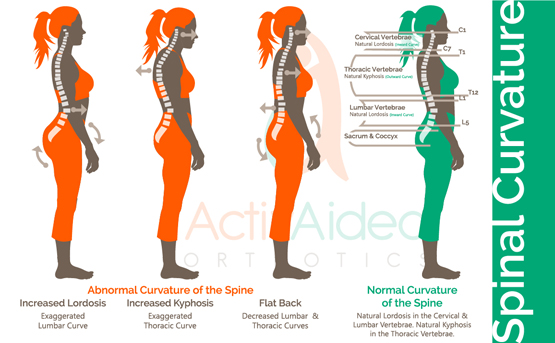
The spine is naturally curved to facilitate its shock absorption, balance, and range of motion. While similar among everyone, the degree of curvature does vary from person to person. Using the following posture tips as your guide, listen to your body to find your correct posture.
- Good posture is maintaining the natural curvature of the spine.
- Bad posture is altering the spine’s natural curves either by exaggerating or flattening them.
What Does the Normal Curvature of the Spine Look Like?
Normal curvature of the spine includes slight inward and outward curves that alternate along the length of the spine and create a wave-like appearance. The cervical, or neck, region of the spine naturally curves inward towards the front of the body. The thoracic, or upper back, region naturally curves outward. The lumbar, or lower back, region curves inward, and the base of the spine, comprised of the sacrum and coccyx, curves outward.
- Lordosis is the term used to describe an inward curvature to the spine.
- Kyphosis describes an outward curve.

What Does Correct Posture Look Like?

What is Correct Standing Posture?
- Shoulders Relaxed
(Not Elevated, Rounded, or Pulled Backward) - Strong Abdomen
- Feet Hips Width Apart
- Arms and Hands Hang Naturally
- Knees Relaxed
(Not Locked) - No Head Tilt
(Not Forward, Backward, or Sideways) - Weight Mostly on Balls of Feet (Not Heels) and Distributed Evenly on Both Feet
Tip: If standing for long periods, occasionally shift weight from one foot to the other, and/or rock from heels to toes. Try not to remain static for more than 30 minutes.
Check Your Standing Posture
- Stand with your head, shoulder blades, and buttocks touching a wall.
- Ensure your heels are two to four inches from the wall.
- Then with the palm facing the wall, slide your hand in the space formed between your lower back and the wall.
- One hand thickness of space is ideal.
- If there is too much space, tighten your abdominal muscles to decrease the curve in your lower back.
- If there is too little space, slightly arch your back till one hand fits comfortably.
- Once correct, step away from the wall attempting to maintain this posture.
What is Correct Walking Posture?
Correct walking posture is an extension of good standing posture. Start with correct standing posture and remember to keep your head up with your eyes looking forward (sorry New Yorkers).
What is Correct Sitting Posture?
- Both Feet Flat on Floor
(Use Footrest If Necessary) - Knees Level with Hips or Slightly Higher
(Two Fingers Should Slip Under the Fore Thigh) - Sit Back in Chair
(No Lumbar Support? Use a Rolled Towel or Small Pillow) - Raise Top of Head Toward the Ceiling, Tuck Chin in Slightly
- Shoulders Relaxed
(Not Elevated, Rounded, or Pulled Backward) - Upper Back and Neck Comfortably Straight
- Arms Flexed at 75 to 90 Degree Angle at Elbow
- Take Standing Breaks Every 15 to 30 Minutes
Check Your Sitting Posture
- Sit at the front edge of your chair and slouch completely.
- Draw yourself up and exaggerate the curve in your lower back as much as your can. Hold for five seconds.
- Release the position slightly. Your body will naturally find its correct curvature after being exaggerated.
Why is Posture Important?
When we maintain correct posture, our bones, joints, and muscles are at their most efficient. As you can imagine, this is very desirable and helps to ward off pain, fatigue, and even arthritis. Good posture is also shown to improve confidence, mood and appearance, all of which are becoming more closely linked with good mental and physical health.
Perhaps most importantly, proper posture is an easy and positive addition to your life. Most of us have complete control over our posture, and a little effort can make a big difference in our health.
How to Permanently Correct Posture
Good posture is natural, but if at first maintaining these posture tips feels awkward or stiff, accept where you’re at and work to slowly retrain your muscle memory. Gradually increase the amount of time you maintain good posture until it is second nature for you. The key is to practice good posture throughout the day, during all of your daily activities.
Tricks to Help You Remember to Maintain Correct Posture Throughout the Day
Sense association is an effective way to trigger memories. Try associating correct posture with a sight or sound that you commonly encounter throughout the day. Then whenever that sensory trigger occurs, hopefully you’ll remember to check your posture. Two of our favorite sensory anecdotes for remembering posture are color and doorways. One of my childhood friends had a mother who told him to check his posture every time he walked through a doorway, and that friend has impeccable posture to this day. More recently, a work colleague told me that she checks her posture every time she sees something gold. If you go with a color, try to be specific. Choose “lime” instead of “green” that way the trigger doesn’t occur so frequently that you get frustrated with the habit.

ActivAided Postural Training Apparel for Lasting Relief
If you want a more subconscious reminder, simply try ActivAided. We developed the ActivAided posture training device to be a comfortable and constant reminder to maintain correct posture. It is a light tank top that uses tactile feedback to subtly cue your body to make the adjustments necessary to achieve your correct spinal alignment. Designed by a practicing spinal health physician, it is easily and discreetly worn throughout the day to help remind you to maintain correct posture, even when your mind is focused elsewhere. Plus, it is 91% effective! Get yours today.
